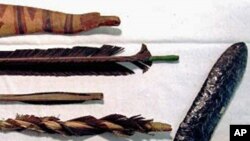The first human inhabitants of North America settled at least 2,500 years earlier than the people previously identified as the first Americans. So say archaeologists, who have unearthed a trove of stone artifacts belonging to the early Americans at an archaeological dig in central Texas, in the U.S. southwest.
The 1,600 ancient stone artifacts, including chipping debris and flecks from sharpened arrow points and so-called bi-facial knife blades, were found lying undisturbed at an archaeological site over 60 kilometers southwest of Austin.
Michael Waters, director of Texas A & M University’s Center for the Study of First Americans, led the dig at the site near the head of a small stream in what’s come to be known as the Buttermilk Creek Complex.
Waters say the latest relics were buried in a clay layer beneath sediment containing artifacts of the Clovis people, thought to have lived in this region between 1,200 and 1,300 years ago and been the earliest American settlers.
But Waters say the stone artifacts include a wide variety of tools dating as far back as 15,500 years ago. "We found many, many chisel-like tools, indicating that people were working bone, working wood, you know, many hard materials," he said.
Archaeologists used a technique called luminescence dating to show when the early settlers arrived. The technique measures light energy trapped in sediment grains surrounding the tools from the last time the layer was exposed to sunlight.
Evidence of Clovis people were first discovered in 1932, and ever since, Waters says, archaeologists have argued about whether other sites also belonged to the Clovis civilization or were older, unrelated settlements. Waters says his team’s findings validate those who argue for an earlier colonization of the Americas.
Waters says the presence of prehistoric humans in the Americas more than 15,000 years ago doesn’t challenge the current theory that humans migrated out of Africa, moved east through Asia and on to the Americas over a Siberian land-bridge to Alaska.
But he says it could mean that the instead of a land bridge, the earliest settlers used boats to come to the Americas.
"By 15,500 years ago, the ice-free corridor, that land corridor connecting Alaska with the mainland of the United States, was closed. The two ice sheets had merged. So, the only route you could take to get south of those ice sheets and down into what is now the continental United States you would have had to have taken a boat. So, I think this clearly shows that people must have arrived in the Americas by boat. The earliest Americans," he said.
An article on an earlier settlement of the Americas is published this week in the journal Science.





